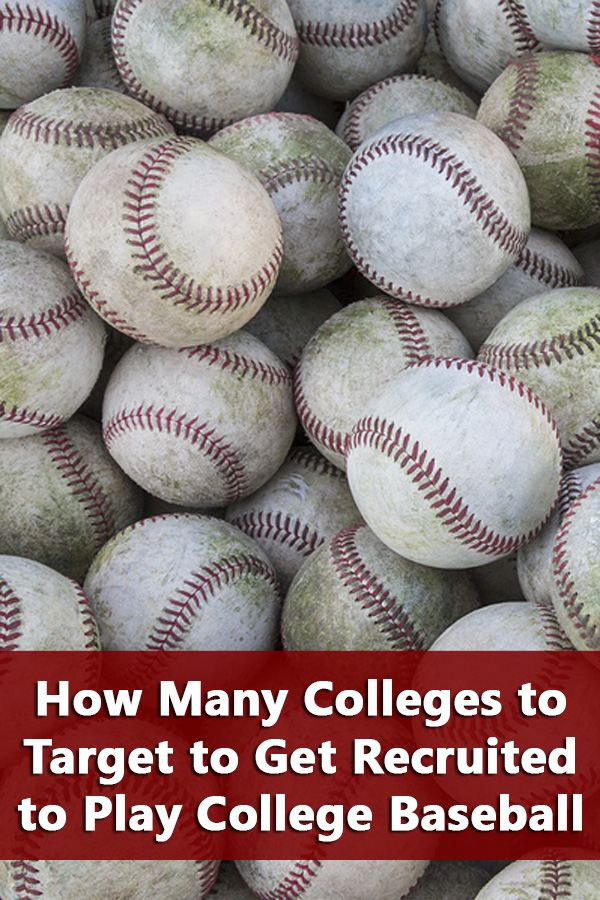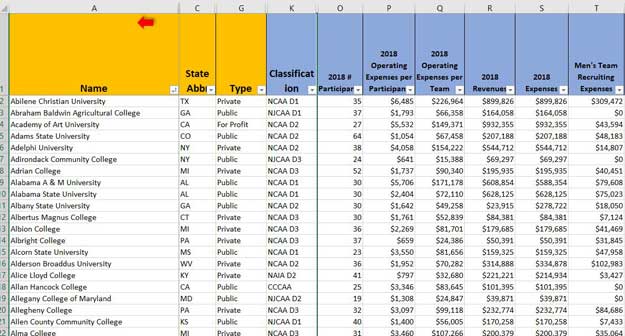 50–that’s the number of colleges you should target if you’re interested in getting to play college baseball at the college level. Too many? Think I might be exaggerating a little? Or maybe I don’t have a clue as to what I’m talking about? Give me a moment and I’ll explain my madness.
50–that’s the number of colleges you should target if you’re interested in getting to play college baseball at the college level. Too many? Think I might be exaggerating a little? Or maybe I don’t have a clue as to what I’m talking about? Give me a moment and I’ll explain my madness.
Let me set the scene. You might be a freshman who’s smart enough to know that with the way baseball recruiting works today, it’s never too early to start looking at colleges. Or maybe you’re a junior who has realized that since you’ve never been contacted by a D1 coach, your chances of playing at the D1 level are probably about the same as getting into Harvard.
In other words, you haven’t set any expectations about the size, location, or type of college you want to play at. You may not even have checked to see if you’re on track to meet the NCAA core courses requirement. (But if you’re a junior, really, what are you waiting for?) You just know that you want to play college baseball.
You will have to start by having a realistic view of your abilities and what level you’re capable of playing at. In other words, you need to know if you’re most likely to play at the D1, D2, or D3 level. Of course, if you’re a freshman, there’s always room for improvement but it’s best to be conservative at this stage.
But I get it, everyone thinks they’re going to play D1 so let’s do a D1 example.
Targeting Colleges to Play Baseball: D1 Example
Can you even name 50 D1 colleges? And this is part of why I say 50. If you’re serious about playing baseball in college, and I’m not even talking about getting a scholarship, you need to expand your horizons to maximize your chances.
Now I know most people will have some sort of geographic limitation when looking for colleges. I believe this is a mistake but I’ll go ahead and use it for the example. We’re going to go with “I don’t necessarily want to live at home but I don’t think I want to have to fly home for the holidays” approach.
Let’s say you live in Virginia. That means that you have 13 D1 colleges with baseball programs in the state representing a total of 8 conferences. The reality is that not all D1 programs play at the same level. This means you’re going to have to decide are you at the ACC D1 level or maybe more at the Colonial Athletic Association level?
So even if you knew all 13 D1 colleges in Virginia, unless you’re a top 100 recruit, only a few of them would be viable options for you-maybe 3 or 4? That means that of the initial list of colleges, only a quarter to a third are possible candidates for you to target to play baseball at.
See where I’m going with this? You can have a list of 50 D1 colleges and probably only somewhere to 12 to 15 are going to match your abilities.
However, I suggest that the 50 colleges you target should just be those that are likely to be a match in terms of your baseball abilities. You can expand your list by looking at other teams in the conference and then check their schedules and see which non-conference teams they play and add them to your list.
Not All Colleges Will Need Your Position
And while you’re on the web pages, take the time to look at the actual baseball team rosters. Now once upon a time, when coaches only recruited high school juniors, you could look at the rosters and see if there might be openings coming up for your position. Times have changed and the transfer portal has added a completely new dimension. Therefore, this probably isn’t going to be a very accurate predictor in today’s recruiting world.
But I’m telling you to look just as an example. Say you were going to be a college freshman next year, what would be the chances the baseball coach would need someone at your position? Now you see the next reason why you need a big list to start with. The coach just may not be recruiting for anyone at your position for the coming year.
Of course, there’s no way of knowing without asking the coach which you will have to do. But if you only have targeted 12 to 15 schools that match your ability to work with, you could potentially find half of them eliminated because of your position.
And What About the Education Part?
Notice that we haven’t even started talking about if you have the grades and scores to get in. (Even if the NCAA doesn’t require test scores, individual colleges still might include it in their admissions requirements.) Nor have we mentioned looking at things like size, big city or small, or even majors. And remember, we also haven’t factored in that even if the coach thinks you’re a match for his team, he’s also recruiting 2 or 3 other players for the same position and may end up liking them better. Or that maybe you just don’t think you’re a good fit for his coaching philosophy.
Targeting 50 colleges is not such an unreasonable number after all when you think about it as the number to begin with. You certainly won’t be applying to 50 colleges. But if you want to be applying to 5 colleges where you know where you’ll have the chance to play baseball for a coach who wants you at a school that meets your academic and social needs, 50 is not that outrageous of a number to start with.
Start targeting the college that will recruit you with a complete listing of baseball colleges.
CONNECT WITH OTHER PARENTS WITH PROSPECTIVE COLLEGE ATHLETES
JOIN THE COLLEGE RECRUITING PARENT ZONE




1 thought on “How Many Colleges to Target to Play College Baseball”